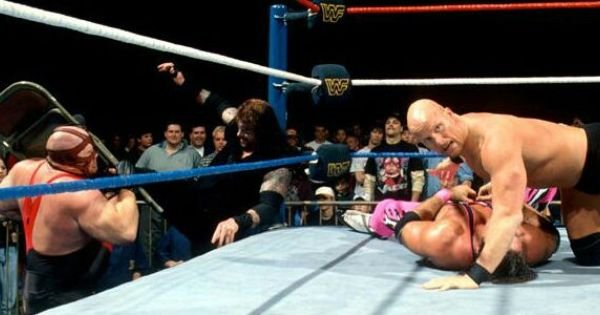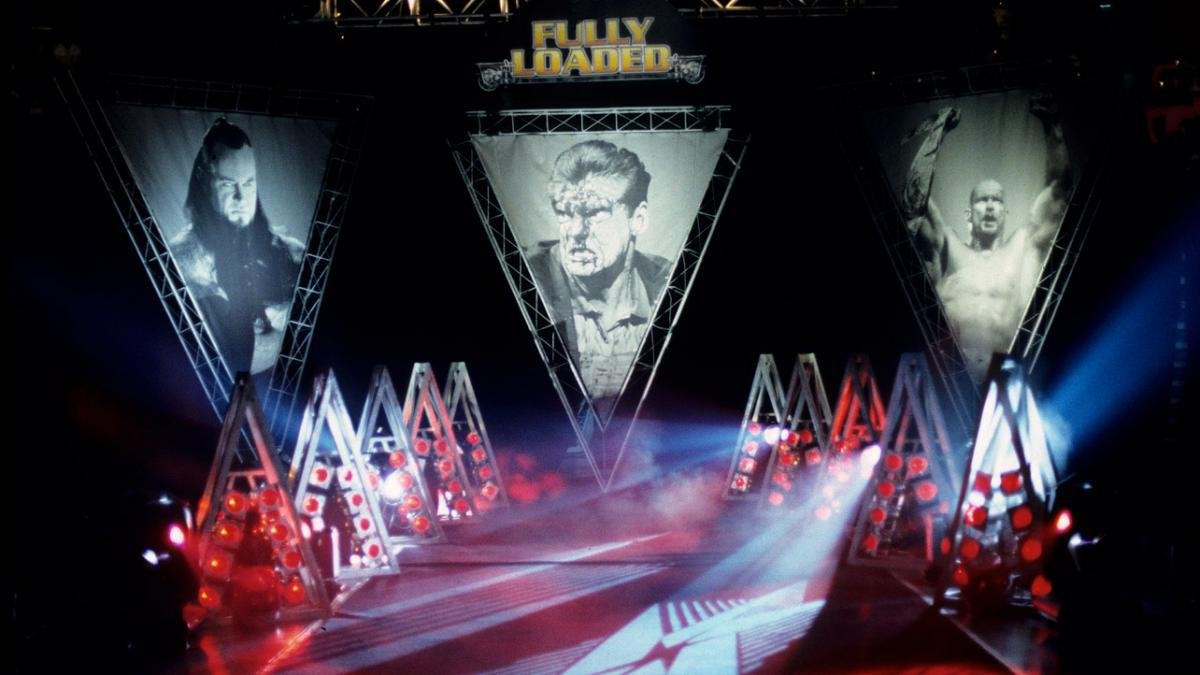Wrestler Spotlight: Jinsei “Hakushi” Shinzaki
When fans speak of Jinsei Shinzaki, most talk about his prowess in Michinoku Pro Wrestling. United States fans might know him better as Hakushi from the World Wrestling Federation (WWF, now known as the WWE), “The White One.”
Before starting his long journey in the wrestling business, Shinzaki chased different careers as a soccer player and then as an actor. That was left in the dust as he met famed Japanese wrestler Gran Hamada. Jinsei would train in the Mexican style of Lucha Libre before debuting in Universal Lucha Libre in 1992. He would wrestle under a mask of a Mongolian Yuga.
Shinzaki followed renowned wrestler The Great Sasuke to his promotion, Michinoku Pro Wrestling. A name familiar to many WWE fans as the promotion brought the United States fans Taka Michinoku, Dick Togo, Funaki, Sasuke, and Hakushi. Mongolian Yuga was transformed into Jinsei Shinzaki, “Jinsei for the word life.” In this character, Jinsei often prayed, dressed in all white, slowed down his in-ring style, and was in a heel faction with Super Delfin to “curse” The Great Sasuke with his prayers.
After internal bickering, Shinzaki would find himself turning face and allying with Sasuke and his allies. Shinzaki also performed for the WWF when they were touring Japan. He impressed WWF Management so much he was offered a contract.
Renamed Hakushi in the WWF, he would debut with wins over Matt Hardy (a young up-and-comer at the time), Aldo Montoya, The 1, 2, 3 Kid and others. He was managed by Shinja (aka Akio Sato) and would continue dressing in all white but was presented as a heel. His lucharesu wrestling style came out in full force while captivating WWF fans.
His Summerslam 1995 match with the 1, 2, 3 Kid was a 10-minute action fest. High flying, fast-paced, and the crowd was into the action from bell to bell. Hakushi seemed to be in a bit of trouble as the Kid went for one of his signature spin heel kicks, but Hakushi caught the Kid and performed a one-arm powerbomb into a pin to earn the victory.
One of the most notable and unique things about Hakushi was his entrance. This caught the attention of the WWF fans. Long-time songwriter and producer for the WWF/WWE Jim Johnston, when speaking to WWE.com, told his story of the origins of Hakushi’s “Angels” entrance.
“I gave the song to Vince [McMahon],” Johnston recalled. “And I said, ‘If you ever have a Superstar that is, in some way, the opposite of The Undertaker by wearing all white, I’ve got a theme for him.”
After passing off the tune, Johnston never believed it would surface on WWE programming, but it was the perfect accompaniment to the mysterious acrobatics of mid-90s Japanese daredevil Hakushi.
“I thought it was long forgotten,” Johnston admitted. “I think it was a year later, and then sure enough, Hakushi showed up, and Vince gave him that song.”
Hakushi found himself on the Pro Wrestling Illustrated top 500 after debuting in the WWF in the top 50 wrestlers at 48. In part, he had a feud with Kwang the Ninja (Kwang, also known as Savio Vega). When they were partnered, Hakushi would turn on Kwang and the short-lived tag team was on the outs. This led to arguably one of the most underrated feuds in WWE wrestling history.
Hakushi vs Bret “The Hitman” Hart
Hakushi and Bret would start a feud that led to no less than 26 matches, most of which Hakushi would take the losses, but he was never losing. He was working with Bret Hart and winning in all aspects of wrestling as a young wrestler working with the ultimate ring general.
From Jinsei Shinzaki’s journals were incepts:
Today is the PPV Event “In Your House”. I didn’t get enough sleep and training in the morning was tough. Perhaps because of my anxiety, time passes quickly. I thought I had 5 hours left to prepare, but it was already an hour before it started. My legs feel tangled. Am I nervous? Mentally I am going to be calm, but my body can’t keep up. The match has ended. It was a great match. My best ever. The crowd reacted great. I can’t breathe due to tension I had. I was doing everything feverishly and I ended up hitting my head hard during the brainbuster outside of the ring. I hit the quebrada clean, but I hit my head on the guard rail. I was very satisfied overall with the match though.
The match occurred on May 14, 1995, which Hakushi refers to. The first WWF “In Your House” Pay Per View event occurred in Syracuse, New York.
Bret and Hakushi undoubtedly had in-ring chemistry. From the pace of the match to the slow-down maneuvers to the uptick in action and surprise moves and counters, they had a great flow which the crowd reacted to. Hakushi was seen as a high-flyer with a faster pace to his matches, versus Bret, an in-ring general and technician. You would never know from the in-ring performance Hakushi had high anxiety.
The headlocks to the arm bars were clean. Shoulder blocks to an arm drag, to moonsaults were crisp. Outside the ring, although Hakushi hit his head, the care to give the crowd different action doesn’t go unnoticed. They did hook the crowd in for the opening match, which set the pace for the rest of the PPV.
In the end, the match saw Shinja try and interfere with Bret getting back in the ring. This led to Hakushi doing the Asai Moonsault. He would get back into the ring, Bret would beat the ten count, then reverse a suplex, and into another reversal into a rollup and pin on Hakushi.
Bret won, but so did Hakushi. The fan reaction to the match was buzzing.
Unfortunately, the toll of constant travelling, not speaking the best English, and the long days were taking their toll on Hakushi, as were crowds that were not showing up in droves in the mid-’90s and were booing his performances. Physically he seemed beat up and unable to get himself in an excellent mental and physical place.
However, Hakushi also noted that getting to wrestle Bret Hart was worth his journey to the WWF during this time. Slowly after a cage match that Bret won. The fans again provided rave reviews for the match. Hakushi started to receive a push as a babyface and seemed to be mentally better. He went from having, in his mind, bad matches to better matches with the Fake Doink, Bodydonna Skip, and Barry Horowitz. Fans were accepting him more and more. But this was short-lived.
The journey would end in the WWF after a match with Justin “Hawk” Bradshaw, aka JBL. Hakushi would be hit with Bradshaw’s branding iron after taking the loss. That week on WWF Superstar, Jim Ross reported after being humiliated by the branding Hakushi had left the WWF.
Shinzaki would return to his native Japan and wrestle for several promotions: New Japan Pro Wrestling which saw him take on the Great Muta. The match had a mystic and supernatural vibe that showed Muta embracing his inner evil and Shinzaki his inner good. The match saw Muta get the victory, but Shinzaki reinvented himself.
Jinsei would then find himself back in Michinoku Pro, where he again aligned himself with The Great Sasuke and went on a single undefeated run in 1997. The highlight of his run would come as an undead version of himself being “killed” in his feud with Muta. This led to a match with the WWF’s Undertaker in October. He was brought to the ring in a coffin and blood stains from the feud with Muta. “The Dead Man” would defeat Shinzaki with his Tombstone Piledriver.
Shinzaki would have run in Frontier Martial-Arts Wrestling, Extreme Championship Wrestling, and All Japan Pro Wrestling, but he found his home back in Michinoku Pro. He would become their President in 2003 and has remained there ever since. He is a founding father of Sendai Girls Pro Wrestling along with NXT’s Legend Meiko Satomura. His charity work after the Tsunami in 2011 is often mentioned and praised.
Hakushi was an enigma in the WWF. Athletic, unique, and able to adapt as an in-ring character. His struggles with anxiety and being his worst critic should not be overlooked, as he still managed to have several great matches with 1,2,3 Kid and Bret Hart. If you can watch In Your House, give it a go, you won’t be disappointed.
Note: Most recently, Haksuhi teamed with AKIRA, & Naomichi Marufuji to face the team of Great Muta, Sting & Darby Allin.



